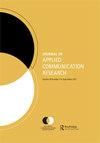E-sisters and the case of the Essure coil: power, representation, and voice in women’s public docket accounts to the FDA of medical device adverse events
IF 1.7
2区 文学
Q2 COMMUNICATION
引用次数: 0
Abstract
ABSTRACT One in ten U.S. patients has an internally implanted medical device. Yet, lax regulation by the U.S. Food and Drug Administration (FDA) has resulted in the approval of medical devices disproportionately harming women, including Bayer Pharmaceutical’s Essure, a permanent female sterilization device. Victims of Essure often suffer adverse events, including serious injuries, device malfunctions, and death. Guided by critical feminist theorizing, this case study examines 500 public docket comments written to the FDA by female patients recounting their experiences of adverse events with Essure. Reflexive thematic analysis revealed how women: (a) voiced their experiences to contest meanings of ‘safety,’ expressed identification with their ‘E-Sisters,’ and protected future women from harm; (b) identified forces of greed, deception, and gender bias as creating the conditions for harm to befall them; and (c) enacted resistance and called for a change in the status quo by the FDA and Bayer. Theoretical and practical implications for health communication researchers, medical practitioners and educators, and regulatory agencies are offered.电子姐妹和电子线圈的案例:权力,代表性,以及女性向FDA提交医疗器械不良事件的公共档案的声音
十分之一的美国患者有内部植入的医疗设备。然而,美国食品和药物管理局(FDA)宽松的监管导致医疗器械的批准不成比例地伤害女性,包括拜耳制药公司的Essure,一种永久性女性绝育器。Essure的受害者经常遭受不良事件,包括严重伤害、设备故障和死亡。在批判女权主义理论的指导下,本案例研究检查了500个由女性患者写给FDA的公开评论,这些女性患者叙述了她们使用Essure的不良事件的经历。反身性专题分析揭示了女性如何:(a)表达她们的经历来挑战“安全”的含义,表达对她们的“e姐妹”的认同,并保护未来的女性免受伤害;(b)确定贪婪、欺骗和性别偏见的力量为伤害降临她们创造了条件;(c)制定了耐药性并呼吁FDA和拜耳改变现状。为健康传播研究人员、医疗从业者、教育工作者和监管机构提供了理论和实践意义。
本文章由计算机程序翻译,如有差异,请以英文原文为准。
求助全文
约1分钟内获得全文
求助全文
来源期刊

Journal of Applied Communication Research
COMMUNICATION-
CiteScore
4.00
自引率
8.70%
发文量
52
期刊介绍:
The Journal of Applied Communication Research publishes original scholarship that addresses or challenges the relation between theory and practice in understanding communication in applied contexts. All theoretical and methodological approaches are welcome, as are all contextual areas. Original research studies should apply existing theory and research to practical solutions, problems, and practices should illuminate how embodied activities inform and reform existing theory or should contribute to theory development. Research articles should offer critical summaries of theory or research and demonstrate ways in which the critique can be used to explain, improve or understand communication practices or process in a specific context.
 求助内容:
求助内容: 应助结果提醒方式:
应助结果提醒方式:


